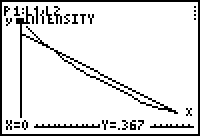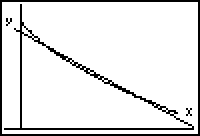
The purpose of this investigation was to develop alternative methods of measuring the area of a copper electrodeposition cell. Two methods were used. The Calculator Based Laboratory system (CBL) and a TI-83 graphing calculator collected data with a light probe. A calibration curve for incident light was made and then compared to the amount of incident light blocked as the electrodeposition of copper formed under different concentrations. For low concentrations of copper sulfate there appears to be relationship between the amount and aggregate formed and the light that is blocked from the probe. For higher concentrations of the aggregate, we unable to detect a noticible relationship. The second method used captured images from a video camera imported into the program Fractal Dimension. In Fractal Dimension the image was scanned at the level of one pixel. We found an inverse linear relationship between the area of the deposition and the mass of the copper metal. The mass of the metal was calculated using Faraday's equation.
To test our hypothesis we first obtained a calibration curve using 1 cm2 pieces of cardboard placed on the top of the electrochemical deposition cell. We took readings from 1-25 cm2, which covered approximately two-thirds of the can. We then ran numerous samples of each concentration of copper sulfate solution (0.2M, 0.4M, and 0.8 M) and recorded variations in the intensity of the light as each aggregate grew. The only variable we tested was the amount of light detected by the CBL light probe as the copper aggregate formed. For the materials used and the steps of our procedure, please refer to the student directions that are attached.

Fig. 1. Mass of Copper metal vs. area measured in pixels
We were able to show that a light probe is sensitive enough to show a relationship between surface area and mass provided the deposition was thicker due to a lower molarity. We concluded that there is a relationship between area and mass of material deposited. We also learned how to collect data and analyze it using the CBL. This experiment would benefit students because they would learn how to use the CBL and how to do the electrodeposition experiment.
Introduction:
The shiny chromium surfaces on an expensive automobile are made by immersing the parts into a chemical bath that contains chromium ions and running an electric current through the bath so that the chromium metal attaches to the parts to be coated. In this experiment, copper metal wire and copper sulfate will be placed between two plastic plates and an electric current will be applied. You will also construct a dark box for the CBL light probe and run a calibration curve using 1 centimeter squares. Once the calibration is finished, you will then set up an electrochemical cell and run the experiment to collect data. As the copper aggregate grows, it will block the light coming into the black box, and you will record readings every 10 seconds. This experiment needs to run for approximately 12-15 minutes.
Materials:
Procedure
1. Construct your black box by making a 1.5 cm hole in the metal bottom that is large enough to put the light probe through. Line the inside of the can with black construction paper.
2. Clamp the Pringles can to the ring stand. The bottom of the Pringles can should now be about 2 inches above the table top. Insert the light probe through the hole in the bottom of the can.
3. The flashlight needs to be covered with a double layer of tissue paper and held in place with a rubber band.
4. You will need to construct nine 1 x 1 centimeter squares, three 1 x 2 centimeter squares, two 1 x 3 centimeter squares,and one 2 x 2 centimeter squares. You should have a total of 25 square centimeters.
5. Link the calculator and CBL unit together. Turn them on. Go to program on your calculator. Choose ChemBio or other light programs. Follow the prompts on the display of the calculator until you reach the point where you are asked to determine what kind of measurements you want to take. Select trigger/prompt.
6. Turn your flashlight on, and adjust the probe until it is directly below the flashlight. Place the two plastic plates on the opening of the pringles can. Hit the trigger display on the CBL, and then record the number of squares that are covering the opening. Zero should be the first trial.
7. Notice that the calculator will keep track of the number of trials. Add 1 square centimeter at a time to the plastic. Make sure the square centimeter is inside the diameter of the can. Collect the data for your flashlight and pringles can for twenty five square centimeters.
8. Download your CBL data onto graph-link in your individual folder. Save a graph of your data as a pict-file and your lists L1, & L2. A sample calibration graph is shown below:

Figure 2: # of squares vs. light intensity
9. Set-up your copper electrodeposition cell in the following manner. Wrap your 22 gauge wire around a 250 mL beaker and form a circle. Some of the wire should be left over. Take the 1 mm wire and bend a one inch 90 degree angle on one end.
10. Insert the 1 mm copper wire into the hole in one of the plastic plates from the bottom. Place the plastic on four pennies placed at each corner. Position the 22 gauge wire in the center of the plate and center it around the wire.
11. Start with the 0.2 M solution of copper sulfate and place a small pool of solution inside the 22 gauge wire near the center of the plate.
12. Turn the power supply on and adjust the voltage to 15 volts.You may have to check this with a volt meter.
13. Connect one of the wire lead alligator clips to the positive post on the power supply. Connect the other end of the lead to the 22 gauge wire on the electrodeposition cell.
14. Connect another wire lead alligator clip to the negative post on the ammeter.
15. Connect another wire lead alligator clip to the positive post on the ammeter. Connect the end of this lead to the 1 mm copper wire on the electrodeposition cell. If your cell is connected properly, you should see the copper metal begin to plate out once the power is turned on. Turn the power on briefly to check this.
16. Connect your calculator to the CBL and turn them both on. Find the ChemBio program and follow the instructions within the program to connect the light meter probe.
17. Select the time graph to collect the data. Collect data every ten seconds for 75 trials.
18. On a separate sheet of paper, you need to take amperage readings every 30 seconds for the entire time of the experiment. Once the CBL is sampling you do not have to monitor it until the experiment is done.
19. When the CBL is done collecting data, download CBL data into your
calculator and quit Chembio. Select zoom 9, to see a graph of your
experiment. The amount of light that is blocked out should be
proportional to the amount of copper metal formed on the cell.
A sample graph is shown below:

Figure 3: Time vs.Light Intensity
20. Repeat this experiment for the copper sulfate at concentrations of 0.4 M and 0.8 M.
Questions:
1. Why is it necessary to prepare a light calibration curve before you actually do the experiment. Why did you line the inside of the can with black construction?
2. What is the purpose of covering the flashlight with tissue paper. Set-up the CBL light probe again and take 5 reading without the tissue paper. What is happening?
3. Make a drawing of your electrodeposition cell and lable the following parts. Anode, cathode, which way are the copper ions migrating, where is the copper metal coming from?
4. What is happening in the cell?
5. If you think that something is moving, what is moving and in which direction?
6. Why does the thing you mentioned above in the cell move?
7. What is your evidence?
8. How might the nature of the structure change if the voltage is held constant while: Molarity (concentration) is increased or decreased?
9. What evidence would you look for?
10. How might the nature of the structure change if the molarity (concentration) is held constant while: Voltage is increased or decreased?
11. What evidence would you look for? .
Materials (for a class of 30)
Preparations of Solutions:
Answers to Questions:
1. The copper aggregate forms a fractal pattern with jagged edges. It would be impossible to measure with normal methods. The amount of light blocked out by the copper aggregate is proportional to the amount of light blocked out by the 1 centimeter squares. The can is lined to cut down the amount of light reflected off of the inside of the can.
2. The light from the flashlight is too intense. The tissue paper reduces the amount of incident light. The students should notice that the light meter fluctuates quite a bit without the tissue paper.
3. Insert drawing here.
4. Oxidation and reduction. Electrons are being transferred from the copper wire into the solution, those electrons are now available for the copper ions to pick up and form metallic copper which deposites on the cathode first, and then on successive copper atoms in the fractal pattern.
5. Electrically, electrons are moving from anode to cathode. Copper ions are moving from solution to the cathode. Copper atoms are moving from the anode into solution.
6. The electrons move because of a difference in electrical potential. Between the cathode and anode in this cell. Copper ions move towards the cathode because they are gaining electrons and thus become copper atoms which are no longer soluble. The copper atoms move into solution to replace the copper ions which are plated out.
7. You can look up the electrode potentials for each of the half reactions?
8. We did this yesterday. The .8 M concentration fine filiments, while the .2 produced thicher strands than the .4. Totally contrary to what we thought might happen.
9. Look for thickness and degree of branching that might occur.
10. When the voltage was increased, the strands became narrower and more branched. Which says that the total amount of atoms deposited was less and maybe that they even occured at a slower rate.
11. You can see a definite change in the pattern of the strands almost immediately. The ends of the aggregate split and form very fine filiments.
Extensions: You can determine the fractal dimension program. Measure using pixels on the computer and then comparing that to the known mass deposited as well as the surface area and light relationship.
This lab was developed by Don Higdon, JoAnn Lane, and John J. Mauch at a two week NSF summer institute on Patterns in Nature at Boston University on July 25, 1996. Suggestions can be e-mailed to John at Mauch1312@aol.com.